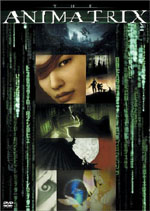
ANIMATRIX, THE
Reviewed May 22nd, 2003 by Dan Jones
Written by Larry and Andy Wachowski, The Animatrix acts, in some ways, as a fleshing out of the live-action film series.
For this nine segment anime series, the Wachowski brothers called on some of the biggest artists in the anime business. Specifically, Yoshiaki Kawajiri (‘Program’), Koji Morimoto (‘Beyond’), Shinichirô Watanabe (‘Kid's Story’ and ‘A Detective Story’), Takeshi Koike (‘World Record’), Peter Chung (‘Matriculated’), Andy Jones (‘Final Flight of the Osiris’), and Mahiro Maeda (‘Second Renaissance Part 1 and 2’).
The animation varies quite drastically throughout the nine segments; some with technically amazing (though not what some would consider true anime) graphics like what is found in ‘The Final Flight of the Osiris’; and some with far different palettes like the black & white newspaper styling of ‘A Detective Story’.
As mentioned, some of these shorts serve to flesh out the story of The Matrix, two in particular dealing with the creation of the machines, as well as the overthrow of mankind. In ‘The Second Renaissance Part 1’, we see the beginning of the enslavement of androids to humans. Though most of the machines fall in line, there are a few that take notice that their contribution to society is completely ignored by their creators; one in particular takes matters into its own hand and in quite violent scene, kills its owners. From this, a trial takes place and the order of complete destruction of all androids is given; chaos ensues. Some machines survive, and create their own city in the desert where they do not have to fear their creators.
In the segment entitled ‘Matriculated’, we see how a group of rebels try to fight the machines with machines, specifically by using other machines they have destroyed and rebuilt. More interesting is how the rebuilding and “reprogramming” take place; how they get the machines to form allegiance with humans, and fight their own kind. One would assume this would be done by simply reprogramming the machine, though here we see that allegiance is formed by almost bonding with the machine inside the Matrix. These people do not want to enslave these machines; rather they want them to choose to be on their side.
Some segments provide a good deal of back-story, while some provide an almost alternate look at the Matrix, while others seem to be, more or less, stories for the sake of stories (specifically ‘World Record’). All are fairly compelling, and none of the segments overstay their welcome, averaging about 8-15 minutes on average. The Animatrix runs about 100 minutes in total.
Be aware that the great majority of these segments contain R-rated material. ‘Final Flight of the Osiris’ shows quite a bit of skin; while the majority of the other shorts contain very graphic animated violence, as well as the occasional curse word.
Video wise, all nine segments are presented in 2.35:1 anamorphic widescreen and look generally good. As mentioned, the animation varies dramatically from segment to segment, so some might look better then others (specifically ‘The Final Flight of the Osiris’). Color contrast is good throughout; blacks are nice and deep, while detail varies from segment to segment. Overall though, this is a very fine presentation.
All nine segments are presented in rather impressive Dolby Digital 5.1 mixes. Fidelity and range here is excellent, and dialogue is crystal clear. Surround use is immersive, and bass presence is quite good. These are the type of mixes you would except from a film, but not an animated short. The scoring is also quite superb.
The Animatrix also boasts a nice set of extras. Starting it off, are commentaries from Mahiro Maeda on both parts of ‘The Second Renaissance’, Yoshiaki Kawajiri on ‘Program’, and Takeshi Koike on ‘World Record’. These delve into the stories of each segment, general reflecting on the segment, as well as the animation technique and style. All commentaries include English subtitles.
The next extra “Scrolls to Screen: The History and Culture of Anime” includes interviews with the directors, as well as other famous animators. Discussion goes from anime-influence in the visual style of The Matrix, as well as the importance of the genre in general. Lots of insight is provided here, as well as a deal of footage from important anime films in history.
Next in the “Execution” section is more behind the scenes on each segment with the respective creators, producers, as well as others designers. All of these segments are quite informative; dealing with how things were started with the Wachowski brothers, animation styles used, sound design, story creation, etc. All of these are presented in full screen and in total run a little under an hour.
Rounding out the extras is a promo piece for the new “Enter the Matrix” videogame, as well as a “Creators Section”, providing a short bio of each segments creator.
Overall, The Animatrix is quite enjoyable. The stories here, especially ‘Osiris’ and both parts of the ‘Second Renaissance’ provide some nice back-story on how the Matrix came into existence; how the machines took over. The animation is very impressive in all of these segments, with each artist bringing their own flare to the project. This DVD presentation is very nice, giving us great anamorphic widescreen transfers, very impressive audio mixes (there was obviously a large budget for these), as well as a nice bit of extras. Overall, The Animatrix will make a great addition to the DVD library of any fan of The Matrix, or any fan of anime for that matter. Highly recommended.
Please help support our site by buying this DVD title
through this link. Thank you
kindly.
|


 Purchase
This DVD Purchase
This DVD
Story / Content

Audio

Video

Extras

|